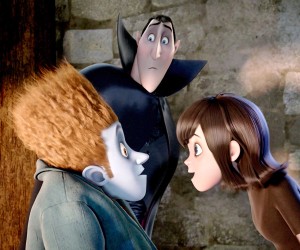Animated film expresses childish fun
An animated movie with Adam Sandler voicing Dracula sounds about as irritating as it gets for anyone beyond the age of eight or for early fans of the actor’s comedy career. Hotel Transylvania\, though, manages to be a harmlessly humorous romp enhanced by director Genndy Tartakovsky’s effort to push the animation to a manic, bubblegum level.

Unusual friendship · Much to the chagrin of Count Dracula, the human Jonathan (Andy Samberg) and the young vampiress Mavis (Selena Gomez) befriend one another in Genndy Tartakovsky’s Hotel Transylvania. – | Photo courtesy of Sony Pictures
In the film, Count Dracula, in an effort to protect his daughter Mavis (Selena Gomez) from the outside world, creates Hotel Transylvania so that monsters can relax in a sanctuary from the human world that they believe still fears and despises them. These creatures include Frankenstein’s Monster (Kevin James), the Wolfman, Wayne (Steve Buscemi) and the Mummy (CeeLo Green).
Many of these characters are back at the hotel for Mavis’ 118th birthday; the “young” vampiress yearns to explore the outside world, even though her father believes that human civilization would only destroy her. Yet in the aftermath of Dracula’s elaborate ruse, a human named Jonathan (Andy Samberg) ends up at the hotel, threatening the safety of the monsters and the reputation of the hotel. The plot, of course, thickens when Jonathan and Mavis begin to form a mutual attraction to one another.
If the film carries a glaring fault, it’s that this kind of father-daughter relationship has been explored again and again in other films, particularly animated ones. And thus, the film becomes predictable; if you’ve seen The Little Mermaid or Finding Nemo (with a similarly protective father-son relationship), you’ll have a very good idea of where this story is going the moment Mavis and Jonathan lay eyes on each other.
But outside the film’s hackneyed plot, Hotel Transylvania moves along briskly.
The voice actors do a fairly good job; Sandler isn’t nearly as annoying as you would expect, and there are moments where he gives the vampiric lord an air of grace and understanding. Still, most of the other voice actors have been featured in his other films, so Hotel Transylvania feels like the cast of a typical Adam Sandler comedy — just with legendary horror creatures. The familiar cast gives off a strange feeling of déjà vu, but it makes the friendship between the characters seem all the more legitimate.
The look and feel of the film boasts the style of the director, Genndy Tartakovsky. Tartakovsky, the creator of Dexter’s Laboratory and Samurai Jack, was the sixth director brought onto the project, which Sony Pictures Animation has struggled with since 2006. The studio allowed Tartakovsky to rewrite the script and push and exaggerate the 3-D animation. The film’s visual style now resembles classic Tex Avery cartoons rather than the realistic images of Pixar.
Though the style doesn’t differ much from the plastic look of Sony Animation’s previous film, Cloudy with a Chance of Meatballs, it definitely keeps the spirit of the simplified approach Tartakovsky is known for. The facial expressions are almost spot-on character takes from Dexter’s Laboratory, and considering Tartakovsky hasn’t done too many projects recently, it’s nice to see him back in the spotlight.
But when the film kicks into high gear, the elasticity and squash-and-stretch technique used for the characters really push the limits of animation techniques. Hotel Transylvania’s form of exaggeration and experimentation is refreshing to see in a major animated feature — especially since recent films have focused too much on how good the graphics look as opposed to what advancements they can contribute to the animation industry.
It must be said, however, that if you really aren’t familiar with Tartakovsky or don’t pay attention to animation styles, this film might be a bit too thin. Hotel Transylvania remains enjoyable on its own terms, but it caters more to children than adults who appreciate more sly, sophiscated comedy.
Hotel Transylvania’s hyperactive humor often covers very familiar ground. The film itself makes commentary in the third act on how these horror legends have become so familiar to the public that the monsters resemble celebrities more than creatures worth fearing. And Hotel Transylvania does manage to avoid relying too much on pop culture references, except for one blatant — yet still very funny — throwaway gag about the Twilight franchise.
But animation buffs and the young-at-heart should definitely check out Hotel Transylvania. And if the film proves successful, it’ll be great to see what Tartakovsky will do next in animation.
Would a Samurai Jack movie be too much to ask for?
